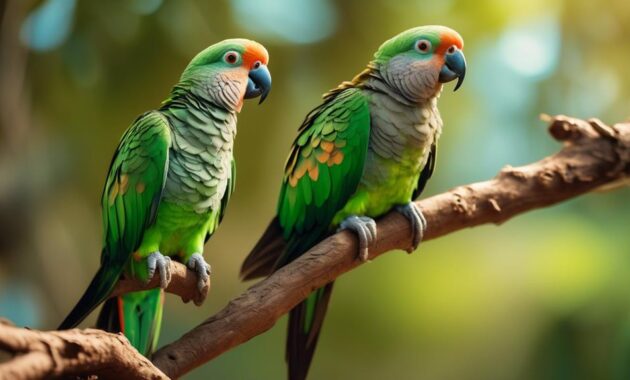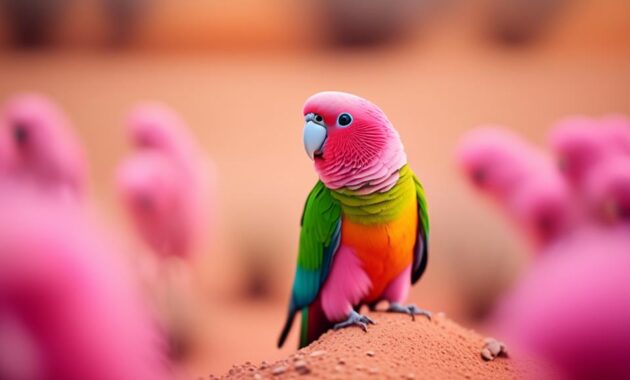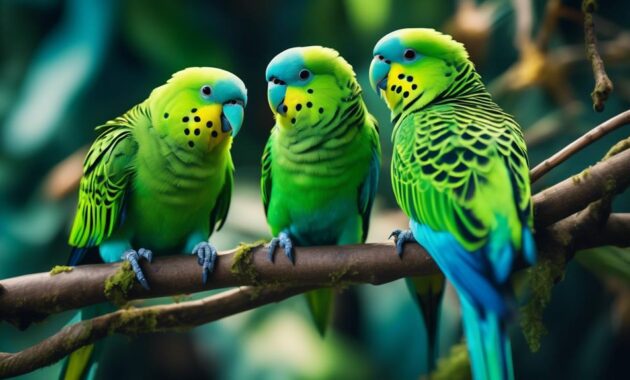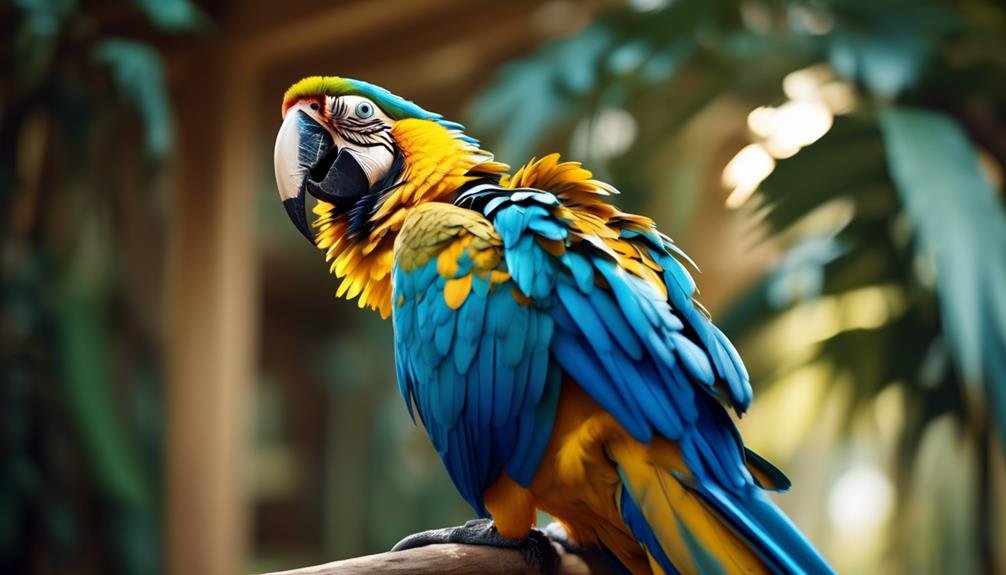
The Blue and Gold Macaw, with its striking plumage and ability to mimic human speech, has captivated the attention of bird enthusiasts worldwide. Imagine being able to have a colorful and talkative companion right in your home – a bird that can greet you in the morning with a cheerful ‘good morning’ or engage in playful banter throughout the day.
But there’s much more to this vibrant creature than meets the eye. From its unique physical characteristics to its fascinating behavior, there are countless aspects to explore when it comes to the Blue and Gold Macaw. So, let’s embark on a journey to uncover the enchanting world of this magnificent bird and discover why it has become such a beloved companion for bird lovers everywhere.
Key Takeaways
- The Blue and Gold Macaw is one of the largest parrots, measuring up to 35 inches in length and weighing close to 3.3 lbs.
- This species can live for 50 to 60 years and rarely becomes ill. Apathy, drooping wings, and loss of appetite are major alarms for their health.
- Blue and Gold Macaws are affectionate, playful, and intelligent birds, known for their ability to deeply bond with their owners. They make perfect family pets.
- The vibrant appearance of the Blue and Gold Macaw, with bright blue back and wings, vibrant yellow belly and underside, black chin strap, naked white face, and lime-green forehead, makes them visually striking.
Size and Physical Characteristics
The Blue and Gold Macaw is a majestic bird that measures up to 35 inches in length and weighs close to 3.3 lbs. With a wingspan reaching 43 inches, these birds require a spacious cage and a lot of room and time outside of it.
In terms of lifespan and health, they can live for 50 to 60 years and rarely become ill. The main care they need is hygiene, including regular bathing and cleanliness. Apathy, drooping wings, and loss of appetite are major alarms for their health.
As a parrot, the Blue and Gold Macaw is one of the largest in the parrot family. They’re affectionate, playful, and intelligent, and have a tendency to deeply bond with their owners. This makes them a perfect family pet.
Lifespan and Health
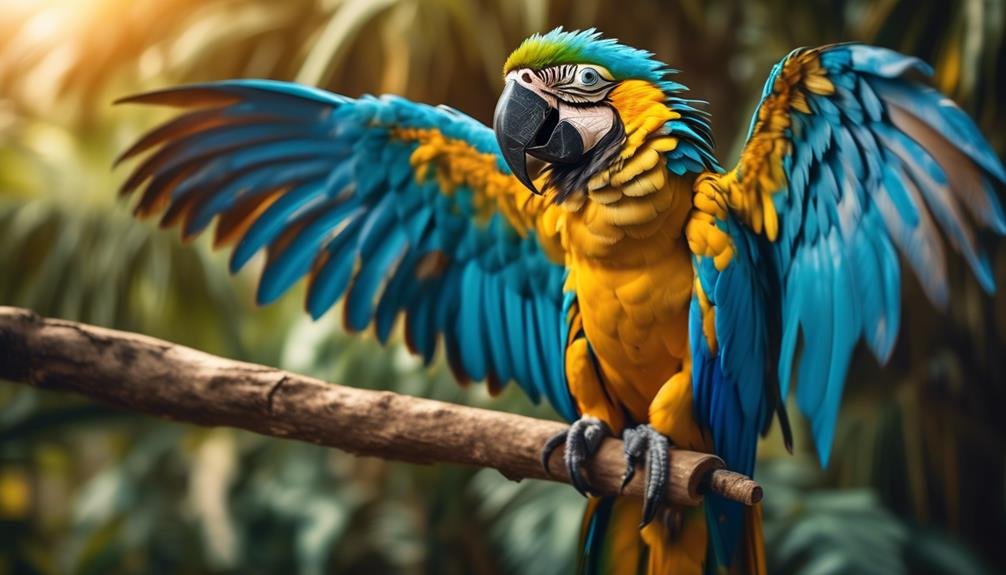
Moving on to the topic of lifespan and health, Blue and Gold Macaws can live for an impressive 50 to 60 years and rarely experience health issues. Here are some key points to consider:
- Main care is hygiene: Regular bathing and cleanliness are essential for their well-being.
- Major alarms: Apathy, drooping wings, and loss of appetite are signs that something may be wrong.
- Rare illnesses: Blue and Gold Macaws rarely become ill, making them relatively low-maintenance pets.
These vibrant birds have an impressive lifespan, allowing for many years of companionship and enjoyment. By prioritizing their hygiene and promptly addressing any signs of illness, owners can ensure that their Blue and Gold Macaw remains healthy and happy throughout its long life.
Bird Species and Personality

Affectionate, playful, and intelligent, the Blue and Gold Macaw is one of the largest parrots in the family and has a tendency to deeply bond with its owner. This makes it a perfect family pet for those seeking a companion that will shower them with love and affection. With its vibrant colors and striking appearance, the Blue and Gold Macaw is sure to capture the hearts of anyone who encounters it. To further evoke an emotional response, here is a table showcasing the endearing personality traits of this magnificent bird:
| Personality Traits | Description |
|---|---|
| Affectionate | Shows love and warmth towards its owner and enjoys physical contact |
| Playful | Loves to engage in games and activities, providing endless entertainment |
| Intelligent | Quick to learn and can be trained to perform various tricks and tasks |
| Deeply Bonding | Forms strong emotional connections with its owner, creating a lasting and loyal relationship |
With such a delightful personality, the Blue and Gold Macaw is truly a remarkable companion to have.
Colors and Appearance

After exploring the affectionate and playful personality of the Blue and Gold Macaw, it’s time to shift our focus to its vibrant colors and striking appearance.
This majestic bird is a true spectacle to behold, with a combination of tropical colors and bright tones that make it stand out among other parrots.
Here are some key features of its colors and appearance:
- Bright blue on the back and wings, creating a stunning contrast with the surrounding feathers.
- Vibrant yellow on the belly and underside, adding a splash of sunshine to its overall look.
- A distinctive black chin strap and a naked white face, giving the bird a unique facial pattern.
- A lime-green forehead that adds another layer of color and adds to its tropical allure.
With its eye-catching colors and stunning appearance, the Blue and Gold Macaw is truly a sight to behold.
Sounds and Communication

The Blue and Gold Macaw is known for its distinct call and ability to repeat words and phrases in a clear and loud voice. This vibrant and talkative bird is a fairly good talker, eagerly learning new tricks and words. With its impressive vocal range, the Blue and Gold Macaw can be quite noisy at times. It uses its powerful voice to communicate with its surroundings and express its emotions.
From playful squawks to affectionate chatter, this parrot is always eager to engage in conversation. Whether it’s mimicking human speech or communicating with other birds, the Blue and Gold Macaw’s vocal abilities make it a highly sociable and communicative companion. Its talkative nature adds to its charm and makes it a delightful addition to any household.
Habitat and Natural Behavior

The Blue and Gold Macaw thrives in a spacious habitat that allows for its natural behaviors and movements. Here are some key points about the habitat and natural behavior of these vibrant birds:
- Natural Habitat:
- Found in the tropical rainforests of Central and South America
- Live in flocks, often in large trees or cliffs
- Require a habitat that mimics their natural environment, with plenty of space to fly and explore
- Flying and Movement:
- Blue and Gold Macaws are excellent fliers, capable of reaching high speeds
- They use their strong beaks and feet to climb and perch on branches
- Enjoy playing and hanging upside down, showcasing their acrobatic abilities
- Foraging and Feeding:
- Spend a significant amount of time foraging for food, using their beaks to crack open nuts and fruits
- Enjoy a varied diet of fruits, seeds, nuts, and vegetation
- Need mental stimulation and enrichment, such as puzzle feeders, to keep them engaged
Diet and Feeding Habits

Blue and Gold Macaws have specific dietary requirements and feeding habits. These magnificent birds need a balanced diet that consists of fresh fruits, vegetables, nuts, and seeds. It is important to provide them with a variety of foods to ensure they receive all the necessary nutrients. A table can help illustrate their dietary needs:
| Food | Quantity |
|---|---|
| Fruits | Daily |
| Vegetables | Daily |
| Nuts | Weekly |
| Seeds | Occasionally |
In addition to their regular diet, Blue and Gold Macaws also enjoy occasional treats such as cooked pasta or rice. It is important to avoid feeding them foods that are toxic to birds, such as chocolate or avocado. Providing fresh water daily is crucial for their hydration. By following these feeding habits, owners can ensure that their Blue and Gold Macaw remains healthy and happy.
Training and Enrichment

Training:
- Consistent and positive reinforcement to reinforce good behavior
- Teaching basic commands such as ‘step up’ and ‘stay’
- Interactive play sessions to encourage mental stimulation
Enrichment:
- A variety of toys to prevent boredom
- Puzzle toys to challenge problem-solving skills
- Rotating toys to keep the bird engaged
These training and enrichment activities help prevent behavioral issues such as screaming and feather plucking. They also strengthen the bond between the macaw and its owner. By providing a stimulating environment, owners can ensure the overall well-being and happiness of their Blue and Gold Macaw.
Tips for Keeping a Blue and Gold Macaw
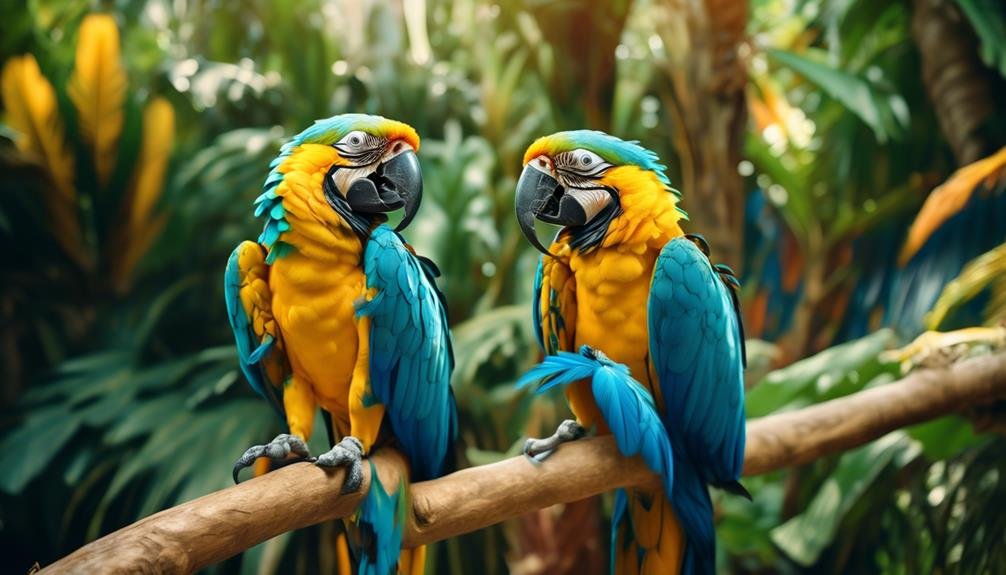
To ensure the well-being and happiness of a Blue and Gold Macaw, owners can follow these essential tips for keeping this vibrant and talkative parrot.
| Tips for Keeping a Blue and Gold Macaw |
|---|
| Provide a spacious cage for the macaw to move around comfortably. |
| Allow plenty of room and time outside of the cage for exercise and socialization. |
| Maintain regular hygiene by bathing the macaw and keeping its living area clean. |
Blue and Gold Macaws require a large cage that allows them to spread their wings and move around freely. It is also important to provide them with ample time outside of the cage, where they can exercise and interact with their human companions. Regular bathing and cleanliness are crucial to their overall health and well-being. By following these tips, owners can create a happy and healthy environment for their Blue and Gold Macaw.
Frequently Asked Questions
Are Blue and Gold Macaws Good With Children?
Blue and Gold Macaws are affectionate, playful, and intelligent, making them perfect family pets. They have a tendency to deeply bond with their owners and are known to be good with children.
How Long Does It Take for a Blue and Gold Macaw to Learn to Talk?
A Blue and Gold Macaw can learn to talk in a relatively short amount of time. It typically takes a few months for them to start mimicking words and phrases.
Can Blue and Gold Macaws Be Trained to Do Tricks?
Yes, Blue and Gold Macaws can be trained to do tricks. They are intelligent and eager learners. With patience and positive reinforcement, they can master a variety of tricks and commands.
Do Blue and Gold Macaws Require Any Special Diet or Feeding Habits?
Blue and Gold Macaws do not require any special diet or feeding habits. They have a varied diet consisting of seeds, nuts, fruits, and vegetables. It is important to provide them with a balanced and nutritious diet to maintain their health and well-being.
What Are Some Common Behavioral Issues That Blue and Gold Macaws May Exhibit?
Blue and Gold Macaws may exhibit common behavioral issues such as aggression, biting, screaming, and feather plucking. These issues can be caused by boredom, lack of socialization, or stress. Proper training, mental stimulation, and a stable environment can help address these behaviors.
Would a Crimson Bellied Conure be a Good Companion for a Blue and Gold Macaw?
The crimson bellied conure characteristics make it a great companion for a blue and gold macaw. Both species are social and enjoy human interaction. The smaller size of the conure also allows for easier handling and less intimidating interactions with the macaw.
Conclusion
In conclusion, the Blue and Gold Macaw is a vibrant and talkative bird that captivates bird enthusiasts worldwide. With its stunning colors, exceptional talking abilities, and affectionate nature, this majestic creature has earned a special place in the hearts of its owners.
From its impressive physical characteristics to its playful personality, the Blue and Gold Macaw brings joy and companionship to any family. With proper care and attention, this magnificent bird can be a beloved companion for up to 60 years.


